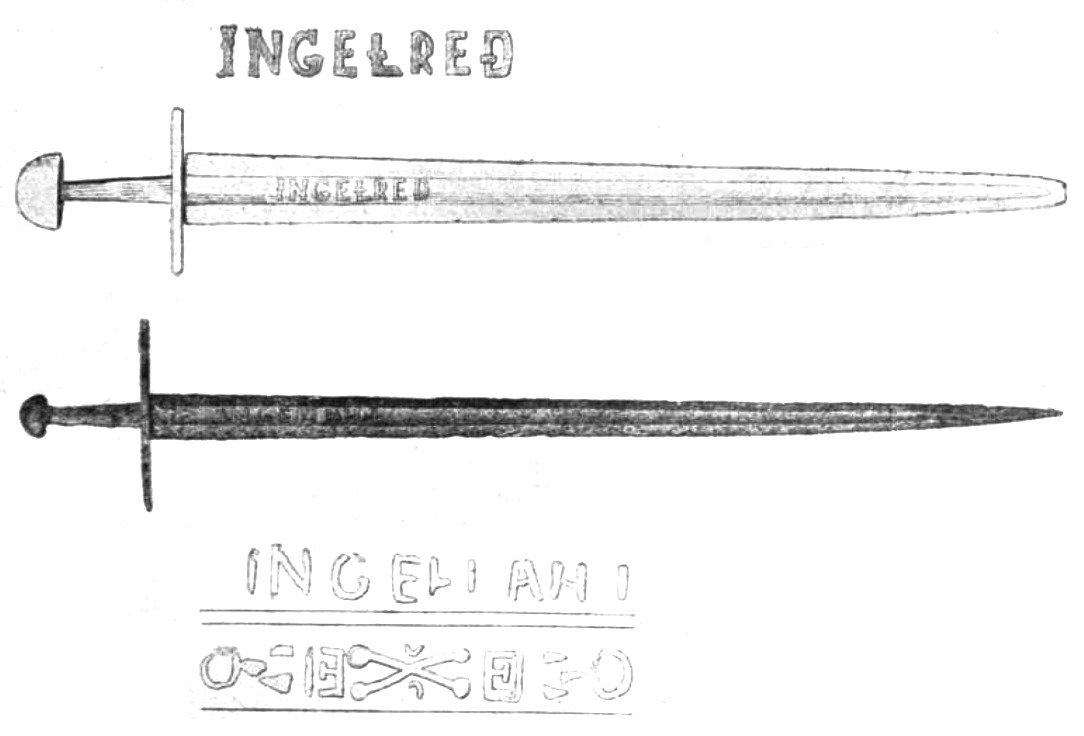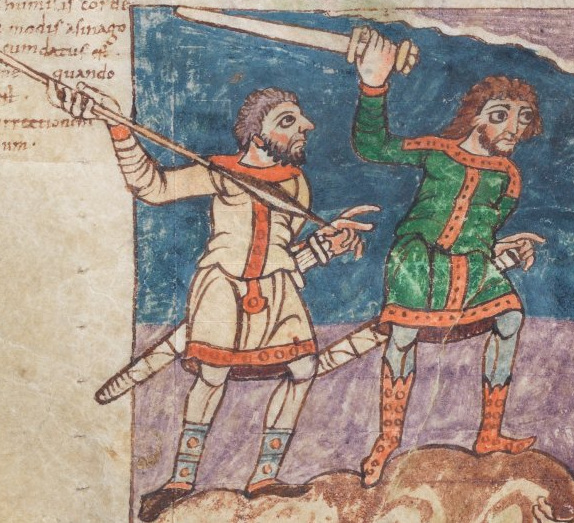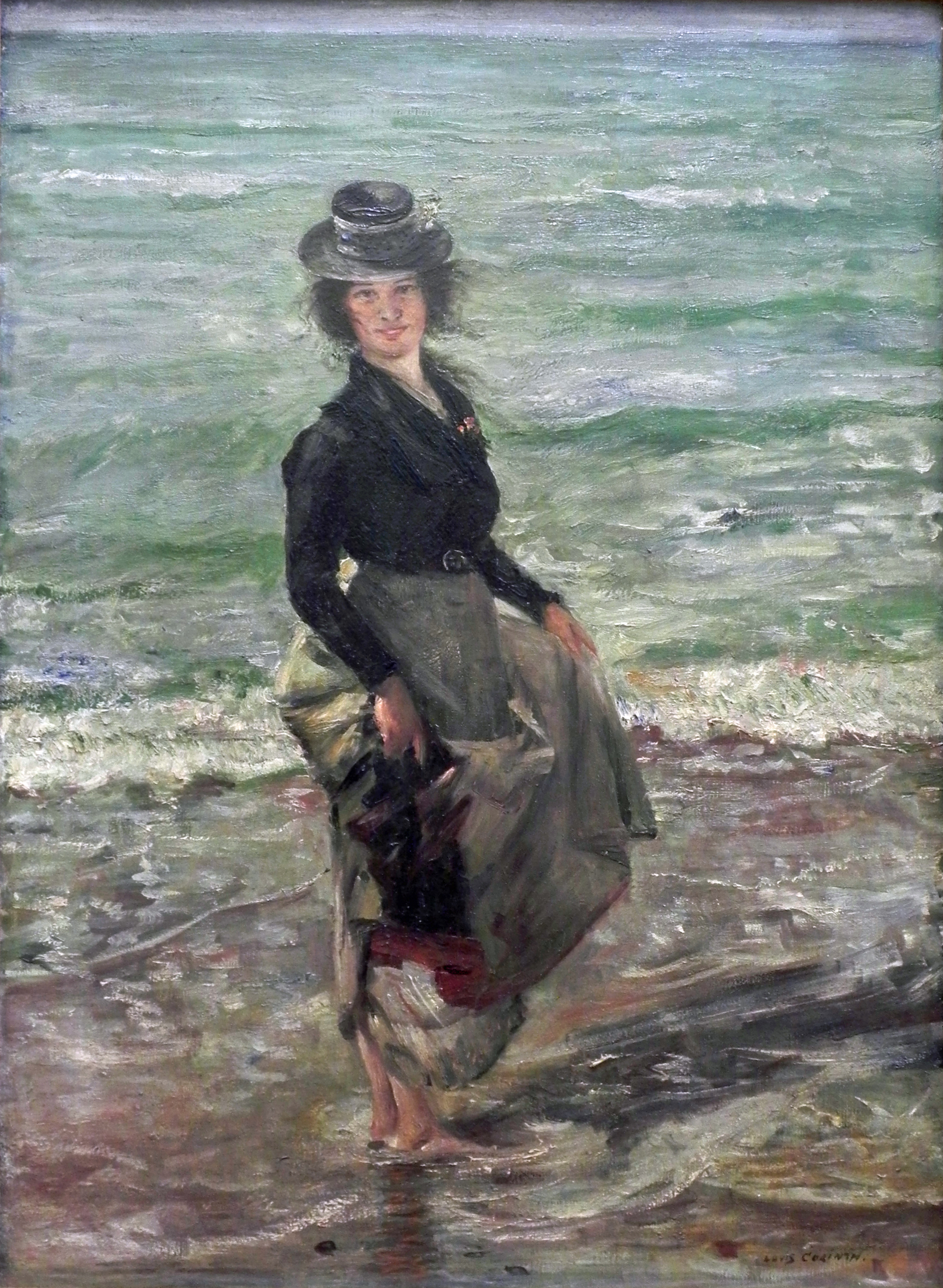|
Ingelrii
The Ingelrii group consists of about 20 known medieval swords from the 10th to 12th century with a damascening blade inscription INGELRII, appearing with several slight spelling variations such as INGELRD and INGELRILT. It is comparable to the older, much better-documented ''Ulfberht'' group (9th to 11th century, about 170 known examples). By 1951, Ewart Oakeshott had originally identified thirteen such swords of this inscription, and had suggested that another, at Wisbech Museum, found in the river bed of the Old Nene in 1895, is also an ''Ingelrii''; supported by Davidson as a possible fourteenth. Other variations of the inscription have also been found: INGRLRIIMEFECIT on a sword found by Sigridsholm, Sweden, and INGELRIH FECIT on a sword found in Flemma, Norway. Known Ingelrii swords *British Museum – ''Ingelrii'', found in the River Thames, along the King's Reach, at Temple *Wisbech Museum – found at Raven's Willow, Peterborough Davidson, Hilda Ellis (1998''The Sword i ... [...More Info...] [...Related Items...] OR: [Wikipedia] [Google] [Baidu] |
Viking Swords
The Viking Age sword (also Viking sword) or Carolingian sword is the type of sword prevalent in Western and Northern Europe during the Early Middle Ages. The Viking Age or Carolingian-era sword developed in the 8th century from the Merovingian sword more specifically, the Frankish production of swords in the 6th to 7th century and during the 11th to 12th century in turn gave rise to the knightly sword of the Romanesque period. Terminology Although popularly called "Viking sword", this type of sword was produced in the Frankish Empire during the Carolingian era. The association of the name "Viking" with these swords is due to the disappearance of grave goods in Christian Francia in the 8th century, due to which the bulk of sword blades of Frankish manufacture of this period were found in pagan burials of Viking Age Scandinavia, imported by trade, ransom payment or looting, while continental European finds are mostly limited to stray finds in riverbeds. Swords of the 8th to 10th ... [...More Info...] [...Related Items...] OR: [Wikipedia] [Google] [Baidu] |
Ulfberht Swords
The Ulfberht swords are a group of about 170 medieval swords found primarily in Northern Europe, dated to the 9th to 11th centuries, with blades inlaid with the inscription ''+VLFBERH+T or +VLFBERHT+''. The word "Ulfberht" is a Frankish personal name, possibly indicating the origin of the blades. Description The swords are at the transitional point between the Viking sword and the high medieval knightly sword. Most have blades of Oakeshott type X. They are also the starting point of the much more varied high medieval tradition of blade inscriptions. The reverse sides of the blades are inlaid with a geometric pattern, usually a braid pattern between vertical strokes. Numerous blades also bear this type of geometric pattern but no ''Vlfberht'' inscription. Ulfberht swords were made during a period when European swords were still predominantly pattern welded ("false Damascus"), but with larger blooms of steel gradually becoming available, so that higher quality swords made af ... [...More Info...] [...Related Items...] OR: [Wikipedia] [Google] [Baidu] |
Viking Age Arms And Armour
Knowledge about military technology of the Viking Age (late 8th to mid-11th century Europe) is based on relatively sparse archaeological finds, pictorial representation, and to some extent on the accounts in the Norse sagas and Medieval Scandinavian law, laws recorded in the 14th century. According to custom, all free Norse men were required to own weapons, and permitted to carry them at all times. Indeed, the ''Hávamál'', purported to be sage advice given by Odin, states "Don't leave your weapons lying about behind your back in a field; you never know when you may need all of sudden your spear." As war was the most prestigious activity in Viking Age Scandinavia, beautifully finished weapons were an important way for a warrior to display his wealth and status. A wealthy Viking would likely have a complete ensemble of a spear, a wooden shield, and either a battle axe or a sword. Battle axes were considered the "normal weapon" for middle class Vikings. Swords were normally reserve ... [...More Info...] [...Related Items...] OR: [Wikipedia] [Google] [Baidu] |
Ulfberht
The Ulfberht swords are a group of about 170 medieval swords found primarily in Northern Europe, dated to the 9th to 11th centuries, with blades inlaid with the inscription ''+VLFBERH+T or +VLFBERHT+''. The word "Ulfberht" is a Frankish personal name, possibly indicating the origin of the blades. Description The swords are at the transitional point between the Viking sword and the high medieval knightly sword. Most have blades of Oakeshott type X. They are also the starting point of the much more varied high medieval tradition of blade inscriptions. The reverse sides of the blades are inlaid with a geometric pattern, usually a braid pattern between vertical strokes. Numerous blades also bear this type of geometric pattern but no ''Vlfberht'' inscription. Ulfberht swords were made during a period when European swords were still predominantly pattern welded ("false Damascus"), but with larger blooms of steel gradually becoming available, so that higher quality swords made af ... [...More Info...] [...Related Items...] OR: [Wikipedia] [Google] [Baidu] |
Peterborough
Peterborough () is a cathedral city in Cambridgeshire, east of England. It is the largest part of the City of Peterborough unitary authority district (which covers a larger area than Peterborough itself). It was part of Northamptonshire until 1974, when county boundary change meant the city became part of Cambridgeshire instead. The city is north of London, on the River Nene which flows into the North Sea to the north-east. In 2020 the built-up area subdivision had an estimated population of 179,349. In 2021 the Unitary Authority area had a population of 215,671. The local topography is flat, and in some places, the land lies below sea level, for example in parts of the Fens to the east and to the south of Peterborough. Human settlement in the area began before the Bronze Age, as can be seen at the Flag Fen archaeological site to the east of the current city centre, also with evidence of Roman occupation. The Anglo-Saxon period saw the establishment of a monastery, Medeshams ... [...More Info...] [...Related Items...] OR: [Wikipedia] [Google] [Baidu] |
Marin-Epagnier
Marin-Epagnier was a municipality in the district of Neuchâtel in the Swiss canton of Neuchâtel. On 1 January 2009, Marin-Epagnier and Thielle-Wavre merged to form the new municipality of La Tène.Amtliches Gemeindeverzeichnis der Schweiz published by the Swiss Federal Statistical Office accessed 14 January 2010 It is located at the northeastern tip of at an elevation of 455 meters, and, , a population of 3,925 people. It lies close to , at the boundary between |
Swiss National Museum
The Swiss National Museum (german: Landesmuseum)—part of the ''Musée Suisse Group'', itself affiliated with the Federal Office of Culture, is located in the city of Zurich, Switzerland's largest city, next to the Hauptbahnhof. The museum building of 1898 in the historicist style was built by Gustav Gull in the form of the French Renaissance city chateaus. His impressive architecture with dozens of towers, courts and his astonishing park on a peninsula between the rivers Sihl and Limmat has become one of the main sights of the Old City District of Zurich. Its inauguration was filmed by François-Henri Lavanchy-Clarke, the first non-french concessionary of the Lumière brothers. The exhibition tour takes the visitor from prehistory through ancient times and the Middle Ages to the 20th century (classic modern art and art of the 16th, 17th and 18th century is settled mainly in the Kunsthaus Museum in a different part of the city of Zurich). There is a very rich section with ... [...More Info...] [...Related Items...] OR: [Wikipedia] [Google] [Baidu] |
Bavarian National Museum
The Bavarian National Museum (german: Bayerisches Nationalmuseum, links=no) in Munich is one of the most important museums of decorative arts in Europe and one of the list of largest art museums in the world , largest art museums in Germany. Since the beginning the collection has been divided into two main groups: the art historical collection and the folklore collection. History and building The museum was founded by King Maximilian II of Bavaria in 1855. It houses a large collection of European artifacts from the late antiquity until the early 20th century with particular strengths in the medieval through early modern periods. The building, erected in the style of historicism by Gabriel von Seidl 1894-1900, is one of the most original and significant museum buildings of its time. It is situated in the Prinzregentenstraße, one of the city's four royal avenues. The house replaced an older building which houses today the Museum Five Continents. Already in 1905/06, the museum ... [...More Info...] [...Related Items...] OR: [Wikipedia] [Google] [Baidu] |
Oakeshott, Ewart
Ronald Ewart Oakeshott (25 May 1916 – 30 September 2002) was a British illustrator, collector, and amateur historian who wrote prodigiously on medieval arms and armour. He was a Fellow of the Society of Antiquaries, a Founder Member of the Arms and Armour Society, and the Founder of the Oakeshott Institute. He created a classification system of the medieval sword, the Oakeshott typology, a systematic organization of medieval weaponry. Biography Ronald Ewart Oakeshott was born in 1916. His uncle Jeffery Farnol wrote romance novels and swashbucklers and also had a collection of antique swords, through which the young Oakeshott became interested in swords. After leaving Dulwich College, Oakeshott studied at the Central School of Art in London. He worked at Carlton Studios and at A.E. Johnson Ltd as a commercial artist, while still being interested in collecting arms and armour. During the 1930s and 1940s, antique swords could still be acquired relatively cheaply and Oakeshott be ... [...More Info...] [...Related Items...] OR: [Wikipedia] [Google] [Baidu] |
Lower Saxony State Museum
The Lower Saxon State Museum Hanover (german: Niedersächsisches Landesmuseum Hannover, italics=unset, or simply ) is the state museum of Lower Saxony in Hanover, Germany. Situated adjacent to the New Town Hall, the museum comprises the state gallery (), featuring paintings and sculptures from the Middle Ages to the 20th century, and departments of archaeology, natural history and ethnology. The museum includes a vivarium with fish, amphibians, reptiles and arthropods. History Originally the Museum of Art and Science () inaugurated in 1856 in the presence of George V of Hanover based in the present-day Hanover Arthouse (), it was later renamed Museum of the Province of Hanover, or simply Provincial Museum. The museum soon ran out of space for its art collections, prompting the construction of the current building, designed by Hubert Stier in a Neo-Renaissance style, on the edge of the Maschpark in 1902. The building's relief frieze, titled "Key Moments in the Evolution of H ... [...More Info...] [...Related Items...] OR: [Wikipedia] [Google] [Baidu] |
Davidson, Hilda Ellis
Hilda Roderick Ellis Davidson (born Hilda Roderick Ellis; 1 October 1914 – 12 January 2006) was an English folklorist. She was a scholar at the University of Cambridge and The Folklore Society, and specialized in the study of Celtic and Germanic religion and folklore. A graduate of Newnham College, Cambridge, Davidson was a Fellow at Lucy Cavendish College, Cambridge, throughout much of her career. She specialized in the interdisciplinary study of Celtic, Anglo-Saxon and Old Norse religion and folklore, on which she was the author of numerous influential works. Davidson was a prominent member of The Folklore Society, and played an active role in the growth of folklore studies as a scientific discipline. Throughout her career, Davidson tutored a significant number of aspiring scholars in her fields of study, and was particularly interested in encouraging gifted women to pursue scholarly careers. Early life Hilda Ellis Davidson was born in Bebington, Cheshire, England, on 1 O ... [...More Info...] [...Related Items...] OR: [Wikipedia] [Google] [Baidu] |




.jpg)

